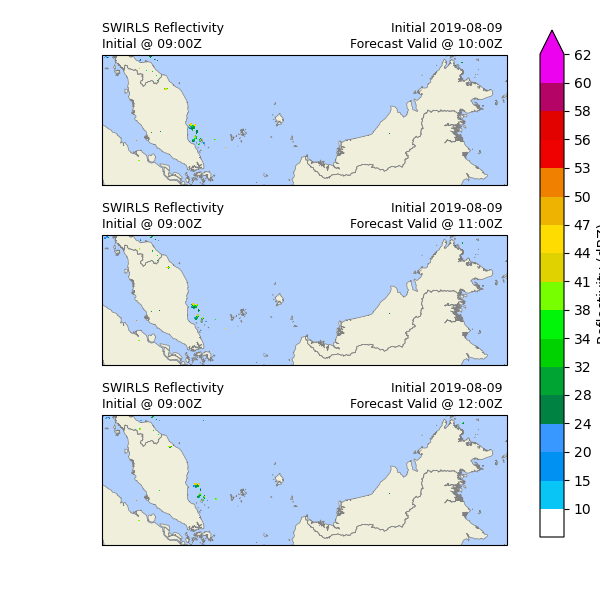Note
Click here to download the full example code
QPF (Malaysia)
This example demonstrates how to perform operational deterministic QPF up to three hours using national radar data.
Definitions
Import all required modules and methods:
# Python package to allow system command line functions
import os
# Python package to manage warning message
import warnings
# Python package for timestamp
import pandas as pd
# Python package for xarrays to read and handle netcdf data
import xarray as xr
# Python package for numerical calculations
import numpy as np
# Python package for reading map shape file
import cartopy.io.shapereader as shpreader
# Python package for land/sea features
import cartopy.feature as cfeature
# Python package for projection
import cartopy.crs as ccrs
# Python package for creating plots
from matplotlib import pyplot as plt
# Python package for output import grid
from matplotlib.gridspec import GridSpec
# Python package for colorbars
from matplotlib.colors import BoundaryNorm, ListedColormap
# Python package for scalar data to RGBA mapping
from matplotlib.cm import ScalarMappable
# Python com-swirls package to standardize attributes
from swirlspy.utils import standardize_attr, FrameType
# Python com-swirls package to calculate motion field (rover) and semi-lagrangian advection
from swirlspy.qpf import rover, sla
# directory constants
from swirlspy.tests.samples import DATA_DIR
from swirlspy.tests.outputs import OUTPUT_DIR
warnings.filterwarnings("ignore")
start_time = pd.Timestamp.now()
Initialising
This section demonstrates extracting radar reflectivity data.
Step 1: Define your input data directory and output directory
# Supply the directory of radar and nwp data
data_dir = os.path.abspath(
os.path.join(DATA_DIR, 'netcdf_ms')
)
Step 2: Define a basetime
# Supply basetime
basetime = pd.Timestamp('201908090900')
Step 3: Read data files from the radar data using xarray()
# Radar data listed from the basetime[0] --> 3 hours before the basetime[17] (descending time)
interval = 10 # Interval of radar data
radar_datas = []
for i in range(0, 2):
t = basetime - pd.Timedelta(minutes=i * interval)
# Radar data nomenclature
filename = os.path.join(
data_dir,
t.strftime("radar_d03_%Y-%m-%d_%H_%M_00.rapids.nc")
)
reflec = xr.open_dataset(filename)
radar_datas.append(reflec)
# Concatenate list by time
reflec_concat = xr.concat(radar_datas, dim='time')
# Extracting the radar data: The radar dBZ variable is named 'Zradar', therefore, we extract 'Zradar'
radar = reflec_concat['Zradar']
# Reversing such that time goes from earliest to latest; 3 hours before basetime[0] --> basetime[17]
radar = radar.sortby('time', ascending=True)
# Filtering
radar = radar.where(radar > 15, np.nan)
initialising_time = pd.Timestamp.now()
Nowcast (SWIRLS-Radar-Advection)
The swirls radar advection was performed using the observed radar data Firstly, some attributes necessary for com-swirls input variable is added Secondly, rover function is invoked to compute the motion field Thirdly, semi-lagrangian advection is performed to advect the radar data using the rover motion field
# Adding in some attributes that is step_size <10 mins in pandas.Timedelta>, zero_value <9999.> frame_type <FrameType.dBZ>
standardize_attr(radar, frame_type=FrameType.dBZ, zero_value=np.nan)
# Rover motion field computation
motion = rover(radar)
rover_time = pd.Timestamp.now()
# Semi-Lagrangian Advection
swirls = sla(radar, motion, 18) # Radar time goes from earliest to latest
sla_time = pd.Timestamp.now()
Out:
RUNNING 'rover' FOR EXTRAPOLATION.....
Plotting result
Step 1: Defining the dBZ levels, colorbar parameters and projection
# levels of colorbar (dBZ)
levels = [-32768, 10, 15, 20, 24, 28, 32, 34, 38, 41, 44,
47, 50, 53, 56, 58, 60, 62]
# hko colormap for dBZ at each levels
cmap = ListedColormap([
'#FFFFFF', '#08C5F5', '#0091F3', '#3898FF', '#008243', '#00A433',
'#00D100', '#01F508', '#77FF00', '#E0D100', '#FFDC01', '#EEB200',
'#F08100', '#F00101', '#E20200', '#B40466', '#ED02F0'
])
# boundary
norm = BoundaryNorm(levels, ncolors=cmap.N, clip=True)
# scalar data to RGBA mapping
scalar_map = ScalarMappable(cmap=cmap, norm=norm)
scalar_map.set_array([])
# Defining plot parameters
map_shape_file = os.path.abspath(os.path.join(
DATA_DIR,
'shape/se_asia'
))
# coastline and province
se_asia = cfeature.ShapelyFeature(
list(shpreader.Reader(map_shape_file).geometries()),
ccrs.PlateCarree()
)
# output area
extents = [99, 120, 0.5, 7.25]
# base_map plotting function
def plot_base(ax: plt.Axes):
ax.set_extent(extents, crs=ccrs.PlateCarree())
# fake the ocean color
ax.imshow(np.tile(np.array([[[178, 208, 254]]],
dtype=np.uint8), [2, 2, 1]),
origin='upper',
transform=ccrs.PlateCarree(),
extent=[-180, 180, -180, 180],
zorder=-1)
# coastline, state, color
ax.add_feature(se_asia,
facecolor=cfeature.COLORS['land'], edgecolor='none', zorder=0)
# overlay coastline, state without color
ax.add_feature(se_asia, facecolor='none',
edgecolor='gray', linewidth=0.5)
ax.set_title('')
Step 2: Plotting the swirls-radar-advection, nwp-bias-corrected, blended 3 hours ahead
fig: plt.Figure = plt.figure(
figsize=(5 + 1, 3 * 2),
frameon=False
)
gs = GridSpec(
3, 1, figure=fig,
wspace=0.03, hspace=0, top=0.95, bottom=0.05, left=0.17, right=0.845
)
for row in range(3):
time_index = (row + 1) * 6
timelabel = basetime + pd.Timedelta(interval * (time_index), 'm')
ax: plt.Axes = fig.add_subplot(
gs[row, 0],
projection=ccrs.PlateCarree()
)
z = swirls[time_index].values
lats = swirls[time_index].latitude
lons = swirls[time_index].longitude
title = 'SWIRLS Reflectivity'
# plot base map
plot_base(ax)
# plot reflectivity
ax.contourf(
lons, lats, z, 60,
transform=ccrs.PlateCarree(),
cmap=cmap, norm=norm, levels=levels
)
ax.set_title(
f"{title}\n" +
f"Initial @ {basetime.strftime('%H:%MZ')}",
loc='left', fontsize=9
)
ax.set_title('')
ax.set_title(
f"Initial {basetime.strftime('%Y-%m-%d')} \n" +
f"Forecast Valid @ {timelabel.strftime('%H:%MZ')} ",
loc='right', fontsize=9
)
cbar_ax = fig.add_axes([0.9, 0.105, 0.04, 0.845])
cbar = fig.colorbar(
scalar_map, cax=cbar_ax, ticks=levels[1:], extend='max', format='%.3g'
)
cbar.ax.set_ylabel('Reflectivity (dBZ)', rotation=90)
fig.savefig(
os.path.join(
OUTPUT_DIR,
"swirls_ms_fcs.png"
),
dpi=450,
bbox_inches="tight",
pad_inches=0.1
)
radar_image_time = pd.Timestamp.now()

Checking run time of each component
print(f"Start time: {start_time}")
print(f"Initialising time: {initialising_time}")
print(f"SLA time: {sla_time}")
print(f"Plotting radar image time: {radar_image_time}")
print(f"Time to initialise: {initialising_time - start_time}")
print(f"Time to run rover: {rover_time - initialising_time}")
print(f"Time to perform SLA: {sla_time - rover_time}")
print(f"Time to plot radar image: {radar_image_time - sla_time}")
Out:
Start time: 2025-10-11 04:25:12.153224
Initialising time: 2025-10-11 04:25:12.316922
SLA time: 2025-10-11 04:27:36.091430
Plotting radar image time: 2025-10-11 04:27:45.998242
Time to initialise: 0 days 00:00:00.163698
Time to run rover: 0 days 00:00:01.187261
Time to perform SLA: 0 days 00:02:22.587247
Time to plot radar image: 0 days 00:00:09.906812
Total running time of the script: ( 2 minutes 33.842 seconds)